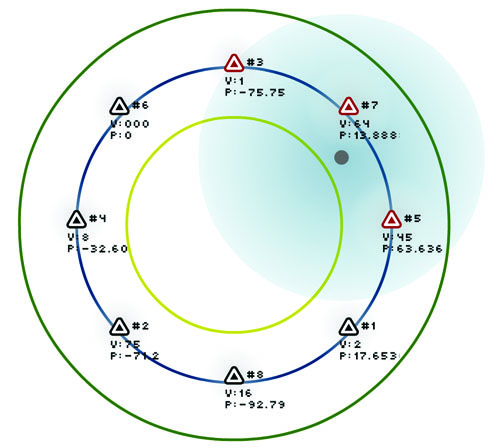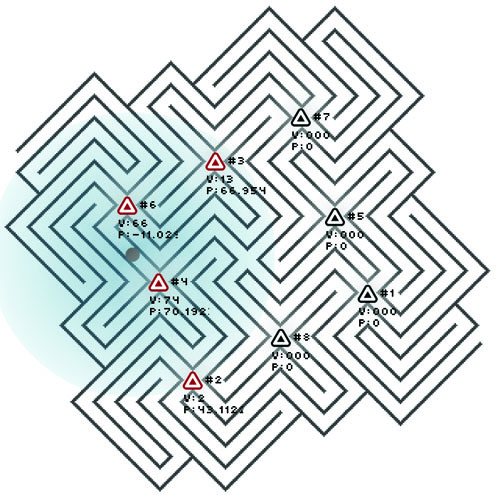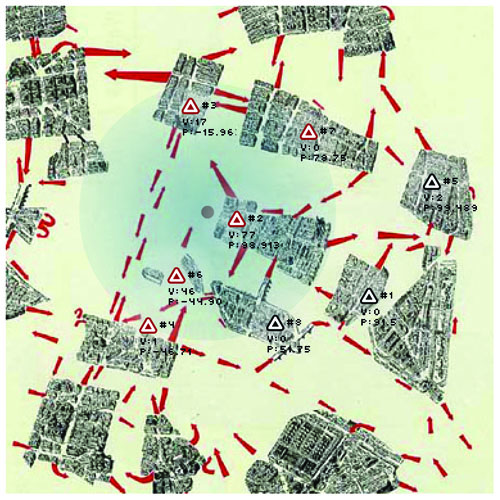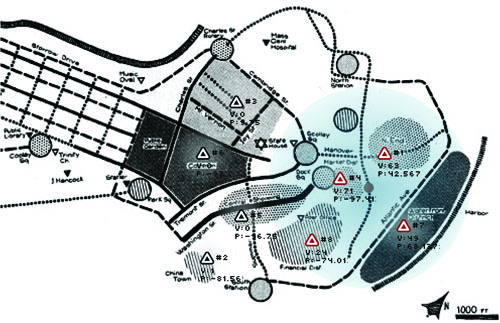Composition-Instrument
Study I
psychogeography and the dérive
A term significant to the early and middle phases of my doctoral research was "composition-instrument." Unlike other complete works that I had completed in the past, this study specifically endeavored to expose the role of each term (composition and instrument) and to address questions about listening, interaction, and the overall sonic palette of my works.
Musically speaking, I have always been interested in creating worlds or moods; ultimately, personal and public spaces with sound. Digital tools make it possible for me to create works where virtual and imaginary spaces can be explored. My interests have always been concerned more with the aural quality of these spaces than the visual, as they offer a different and new potential for music that I have not found in any prior musical endeavors.
In this study, sound spaces are graphically represented as triangles. In the role of poiesist, one has the ability to move through and across sound spaces by navigating with the arrow keys of a computer keyboard. Movement through and across virtual space becomes a means of making music by drawing-out sound. The range of hearing, or "acoustic horizon" (Blesser & Salter 2007), is represented by the circular, blue-gray cloud that appears on the screen. When the acoustic horizon overlaps a sound space (or spaces), the space(s) become audible (see below) and the triangle changes color from black to red. At that point, proximity modulates the overall presence (volume) and position (pan) of a space within the acoustic horizon. Depending on location within the available territory one may be able to hear several spaces at once. The study featured four different ways to approach the same musical/interaction concept:

Orbits: In the first approach, sound spaces are placed along an orbit to guide the poiesist along a path within a fixed range of the various sonic spaces. As one circles the orbit, the size of the acoustic horizon allows enables the construction of different sound combinations relative to the diameter of the chosen orbit.

Maze: The second approach used a maze called Nine Crossroads by Andrea Gilbert (2009). In this example, eight of the nine intersections are home to a sound space that gives the location a unique aural identity. Depending on position in the maze, one to seven spaces may be audible within the acoustic horizon. Again, as position changes relative to each sound space, different permutations lead to shifting musical statements concerning "the maze, at this location, and at this time."

The Dérive: In a dérive (which translates as drift) movement through and across urban environments has an effect on the affect and behaviors of the drift-er. In his discussion of psychogeography, Guy Debord (1955) wrote that differing ambiences from street to street can divide a city into zones. Each zone, created by its perceived psychogeographical character, becomes a unique space within the affective ecology of the larger urban environment.
The map used for this variation of the study was created by Debord (1955) and reflects an amalgamation of many dérive excursions. It shows the psychogeographic zones of Paris and the paths (red arrows) most frequently used to travel between zones. Movement through space creates a variety of sonic relationships between the zones that overlap the acoustic horizon. As with a dérive in the physical world the experience is emergent, as location, memory, and sound come together in a variety of novel combinations.

Urban Imageability: The final variation in the study was derived from ideas in Kevin Lynch’s book The Image of the City (1960) where he considered factors that make a city "legible." The visual character of a city—its "image"—is discernible, and hopefully legible to one degree or another. Legibility, he argues, can facilitate ease of use, including orientation, navigation and richness of experience in an urban environment. This map of Boston reveals a common understanding of urban "spaces" or "zones" that is defined by the architecture, landmarks, streets, and other elements. As one navigates the map, shifts in phrase, texture, and color are based on a "concurrence of Boston"—how it is organized and how its components are interrelated, as understood by the residents who were interviewed and contributed to the map.
Listen to the Duvet maze example:
Listen to Guy Debord Paris dérive: